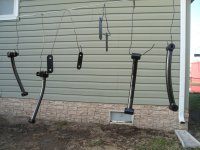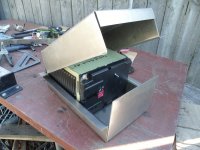Functional Artist
Well-known member
Another feature, that I added to the pedal assembly, was a micro-switch to activate the brake lights 

...& when activated, it also de-activates the motor/traction system
(so, the system cannot be trying to "go" & "stop" at the same time)
* These little switches can be wired/configured as Normally Open & Momentarily Closed when activated (like for this application)
...or Normally Closed & Momentarily Open (when activated) depending on which (2) of the (3) terminals are connected &/or used
* Also, notice this switch is rated for
...0.3A at 250VDC
...0.6A at 125VDC
Going by this "scale" (I'm thinking/IMO) it "should" be able to handle (safely break the current, without damaging itself) ~1.2A at 60VDC
...& then, maybe up to ~1.5A if/when used on a 48VDC system (like this vehicle will have)
** The brake light & running light circuits are powered by 48VDC (full pack voltage)
...so, I'm thinking about using (4) 12V LED's trailer marker lights (wired in-series) for the brake lights
...& (4) separate 12V LED's (wired in-series) for the running lights
(just mount (2) of each of them, in each one of the taillight housings)
The 3/4" round 12V LED trailer marker lights, that I plan to use, seem to draw ~0.05A
...& (4) of them, powered simultaneously, should only draw ~0.2A
So, all components in the Brake light circuit, should be able to handle at least 0.5A (AKA 1/2A)
...which is ~3 times higher than the switches (theoretical) rating


...& when activated, it also de-activates the motor/traction system
(so, the system cannot be trying to "go" & "stop" at the same time)
* These little switches can be wired/configured as Normally Open & Momentarily Closed when activated (like for this application)
...or Normally Closed & Momentarily Open (when activated) depending on which (2) of the (3) terminals are connected &/or used
* Also, notice this switch is rated for
...0.3A at 250VDC
...0.6A at 125VDC
Going by this "scale" (I'm thinking/IMO) it "should" be able to handle (safely break the current, without damaging itself) ~1.2A at 60VDC
...& then, maybe up to ~1.5A if/when used on a 48VDC system (like this vehicle will have)
** The brake light & running light circuits are powered by 48VDC (full pack voltage)
...so, I'm thinking about using (4) 12V LED's trailer marker lights (wired in-series) for the brake lights
...& (4) separate 12V LED's (wired in-series) for the running lights
(just mount (2) of each of them, in each one of the taillight housings)
The 3/4" round 12V LED trailer marker lights, that I plan to use, seem to draw ~0.05A
...& (4) of them, powered simultaneously, should only draw ~0.2A
So, all components in the Brake light circuit, should be able to handle at least 0.5A (AKA 1/2A)
...which is ~3 times higher than the switches (theoretical) rating




















